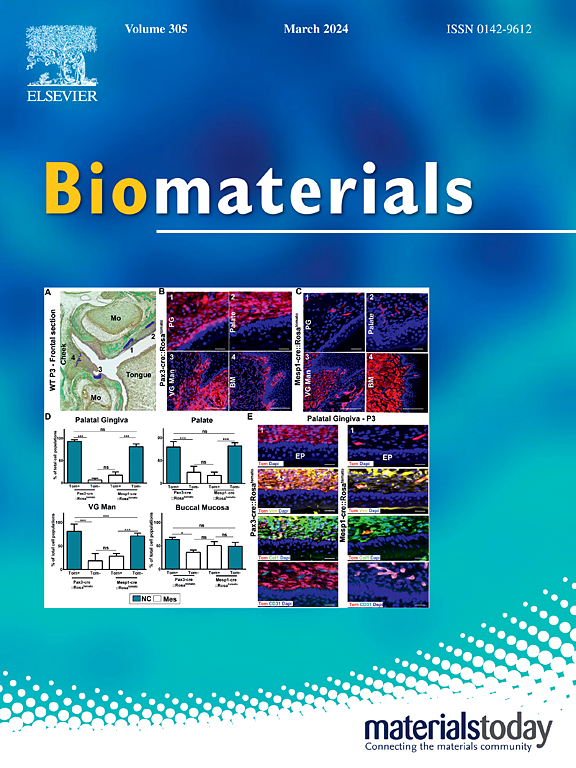Phycocyanin-based multifunctional microspheres for treatment of infected radiation-induced skin injury
IF 12.9
1区 医学
Q1 ENGINEERING, BIOMEDICAL
引用次数: 0
Abstract
Radiation therapy is a primary modality for cancer treatment; however, it often leads to various degrees of skin injuries, ranging from mild rashes to severe ulcerations, for which no effective treatments are currently available. In this study, a multifunctional microsphere (PC@CuS-ALG) was synthesized by encapsulating phycocyanin-templated copper sulfide nanoparticles (PC@CuS) within alginate (ALG) using microfluidic technology. Phycocyanin, a natural protein derived from microalgae, shows abilities to scavenge reactive oxygen species, repair radiation-induced damage to skin cells, and ameliorate macrophage-related inflammatory responses. CuS contributes to photothermal conversion efficiency and exhibits antibacterial properties. The microspheres facilitate the sustained release of PC@CuS, retain moisture at the wound site, and provide a supportive environment for cell migration and growth. In a mouse model of infected radiation-induced skin injury, PC@CuS-ALG exhibited antibacterial and wound healing effects, resulting in accelerated epidermal tissue regeneration, increased thickness and maturation of dermal granulation tissue, and an ameliorated inflammatory response. This study presents a novel, effective, and safe approach for treating radiation-induced skin injuries complicated by bacterial infection.
基于藻蓝蛋白的多功能微球治疗感染性辐射皮肤损伤。
放射治疗是癌症治疗的主要方式;然而,它经常导致不同程度的皮肤损伤,从轻微的皮疹到严重的溃疡,目前尚无有效的治疗方法。本研究采用微流控技术将藻蓝蛋白模板化的硫化铜纳米颗粒(PC@CuS)包埋在海藻酸盐(ALG)中,合成了多功能微球(PC@CuS-ALG)。藻蓝蛋白是一种从微藻中提取的天然蛋白,具有清除活性氧、修复辐射引起的皮肤细胞损伤和改善巨噬细胞相关炎症反应的能力。CuS提高了光热转换效率,并具有抗菌性能。微球促进PC@CuS的持续释放,保持伤口部位的水分,并为细胞迁移和生长提供支持环境。在受感染辐射诱导的皮肤损伤小鼠模型中,PC@CuS-ALG表现出抗菌和伤口愈合作用,导致表皮组织再生加速,真皮肉芽组织厚度和成熟增加,炎症反应改善。本研究提出了一种新的、有效的、安全的方法来治疗辐射引起的皮肤损伤并发细菌感染。
本文章由计算机程序翻译,如有差异,请以英文原文为准。
求助全文
约1分钟内获得全文
求助全文
来源期刊

Biomaterials
工程技术-材料科学:生物材料
CiteScore
26.00
自引率
2.90%
发文量
565
审稿时长
46 days
期刊介绍:
Biomaterials is an international journal covering the science and clinical application of biomaterials. A biomaterial is now defined as a substance that has been engineered to take a form which, alone or as part of a complex system, is used to direct, by control of interactions with components of living systems, the course of any therapeutic or diagnostic procedure. It is the aim of the journal to provide a peer-reviewed forum for the publication of original papers and authoritative review and opinion papers dealing with the most important issues facing the use of biomaterials in clinical practice. The scope of the journal covers the wide range of physical, biological and chemical sciences that underpin the design of biomaterials and the clinical disciplines in which they are used. These sciences include polymer synthesis and characterization, drug and gene vector design, the biology of the host response, immunology and toxicology and self assembly at the nanoscale. Clinical applications include the therapies of medical technology and regenerative medicine in all clinical disciplines, and diagnostic systems that reply on innovative contrast and sensing agents. The journal is relevant to areas such as cancer diagnosis and therapy, implantable devices, drug delivery systems, gene vectors, bionanotechnology and tissue engineering.
 求助内容:
求助内容: 应助结果提醒方式:
应助结果提醒方式:


